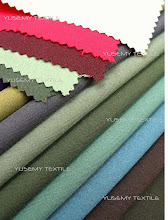Linen fabric or weave is made of fiber from the flax plant, which is widely valued for its durability and strength, as well as its antifungal and antibacterial properties. There are various types of the linen fabric, which can be distinguished from each other by their texture and their weave pattern.
- Damask is a type of linen fabric that is woven on a jacquard loom, using a combination of plain and satin weaves. The fibers are usually flat and reversible, and the damask fabric itself has a smooth texture with a reversible design. It usually comes in one color and is most often used for napkins, tablecloths, table runners and other household materials.
Venise is a very finely textured variety of damask linen fabric. Unlike damask, however, it is characterized by large floral patterns. - Glass toweling is a plain-woven, smooth linen fabric that gets its name from its most common use--for wiping glassware. It typically has a check or striped pattern of red or blue on a white background. Glass toweling has a loose weave that makes it more absorbent and well-suited for cleaning purposes, but also makes it relatively less durable.
Holland linen is a plain-woven linen fabric that is treated with oil and starch, making it opaque and hard for the sunlight to penetrate. This quality makes it well-suited for use in making window shades and lampshades.
Cambric linen is the thinnest and finest variety of linen. This plain woven linen fabric gets its name from Cambria, France, where it was first produced. It is often used for making handkerchiefs, lingerie, doilies and sheers.
Butcher's linen, which has a strong, plain weave, is stiff, coarse and commonly used for heavy-duty clothing such as butcher aprons. It's woven by using thin and thick yarns. - Bird's eye linen is characterized by small geometric patterns that are reminiscent of a bird's eye. It is loosely woven to make it highly absorbent and is commonly used for diapers and sanitary towels. Huckaback is another loosely woven type of linen fabric that is commonly produced from a blend of cotton and linen. It is woven in towel lengths. Art linen is produced from hand-twisted yarns and has a smooth finish.
- This is a heavy type of linen that is usually used in the manufacture of sheets. Another characteristic it has is that of being wide. It is also used in the making of materials for suits and dresses. It has an advantage over the other types of linen because of its wider width, which makes it easier to cut patterns for garments of different lengths and sizes.
- This is the name that is given for all the types of linen that are suitable for the manufacture of towels. Toweling linen comes in different sizes; towels are used for a wide range of purposes.
Linen is considered a luxurious material because processing it from the flax fibers is not an easy procedure, yet the end product is usually very strong and has a high aesthetic value.




